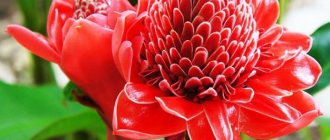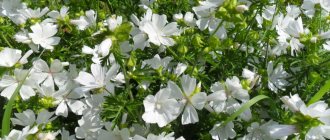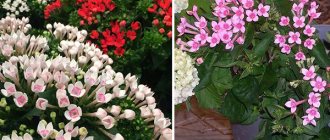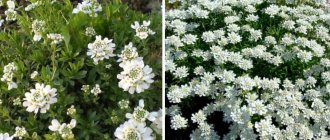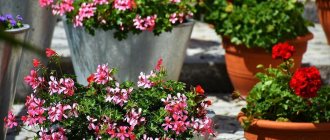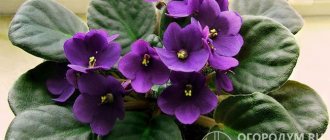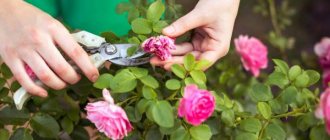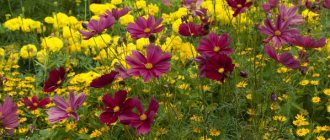Each gardener has his own preferences. Some people like expressive red flowers, while others like pastel shades. There are also those who choose plants with white flowers. This color has always been the personification of purity, tenderness, and innocence. White flowers are combined in a flowerbed with any others, but in themselves they look solemn and majestic. By planting perennials of this color with a long flowering period, you can forget about improving the design of your garden for several years. What plants are we talking about?
Rose
It is not for nothing that the rose is considered the queen of the garden. This flower combines lush splendor and sophistication at the same time. White roses look especially elegant. The flower size of this crop varies depending on the species. The largest buds are produced by the hybrid tea rose; the diameter of its flowers reaches 14 cm. The bushes themselves grow in height from 0.5 to 1.5 meters.
Floribunda is distinguished by the fact that its buds are collected in lush clusters. Flowers are semi-double and double. Climbing roses are placed in a separate class. To grow, they need strong support, as the shoots can reach several meters in length.
White ground cover roses are considered the most frost-resistant; they can be safely planted even in northern regions. Flowers not only look great, but can also produce a pleasant aroma with classic, fruity and spicy notes. Many varieties of roses bloom in 2 waves.
Insects and pollination
It should be noted that this method of pollination is still not suitable for many plants, so they prefer to deliver their pollen to other flowers with the help of winged insects (bees, bumblebees, butterflies), luring them with honey, bright color and incredibly attractive aroma.
It is interesting that plants are quite picky when choosing the insect that is suitable for them: some prefer bees, others prefer bumblebees, and others prefer butterflies. Therefore, depending on preferences, they not only create the shape of flowers, inside of which only a certain type of insect can be found, but also open their petals while this insect is awake (for example, all night flowers have a white color, since only this color is visible in darkness).
Plants that are characterized by early spring flowering, due to which pollination occurs with the help of bees, are white, yellow or blue - bees see only these colors. Closer to summer, a lot of red flowers appear - this tone is attractive to butterflies, which appear much later than bees. It is worth noting that white color is attractive to absolutely all types of insects.
As for the honey that insects hunt for, it is hidden so deep in the flower that a bee, in order to get to it during flowering, needs to get between the pistils and stamens, smearing itself in pollen. After this, flying to another plant, making its way for the next portion of honey, it leaves some of the pollen in the flower.
Clematis
Clematis is a favorite of many summer residents. The liana looks simply luxurious if its shoots are beautifully distributed on a trellis or pergola. The most common white clematis is “Jerzy Popieluszko”. This variety blooms all summer - from June to September. Flowering occurs on last year's shoots, which must be securely covered for the winter to preserve them. The liana reaches the peak of its beauty at the age of 5.
Exotics are nearby: 10 not quite ordinary plants that you can plant in your garden
Popular varieties of white clematis include: "Fargesioides", "Summer Snow", "Arctic Queen", "Bella", "Cassiopeia". “Joan of Arc” looks very impressive; the cultivar belongs to the group of giants. Small-flowered varieties look no less impressive and have a delicate aroma; their shoots do not cling to the support on their own, so they require a garter. The best place to plant clematis is in an area with light shade. The culture is unpretentious in care.
Hydrangea
Hydrangea can be considered a classic plant for garden decoration. All representatives of the culture are large in size and require a lot of space for planting. The bush grows not only tall, but also spreading. White varieties include representatives of two varieties of hydrangea - tree and paniculate.
“White lady” and “Grandiflora” look interesting. The inflorescences of the plant are simply gigantic in size - up to 25 cm. The plant blooms in mid-summer and continues to bloom until frost. In winter, it is better to cut off the inflorescences, since under the weight of snow they can break off, damaging the shoots.
The blossoming flowers are initially snow-white in color, and then acquire a greenish tint. A prerequisite is planting in acidic soil. It is advisable that on the north side the bush is protected from the wind by buildings or a fence. Hydrangeas also like the sun.
Mallow
This plant is also called the stock rose for the similarity of its double inflorescences to the flowers of the queen of the garden. The bush does not take up much space in width, but it grows up to 2 m in height. The plant is often planted in the background of a flower garden or near a wall. Mallow is unpretentious and easily propagated by seeds.
4 common types of garden violets that will become an indispensable flowerbed decoration
Stock rose flowers come in a wide variety of colors; a plant with white buds looks delicate and solemn. Mallow blooms from June to August. The flower bed where this plant is planted will never look empty.
Perennials include the following types of mallow: musky (nutmeg), wrinkled, hybrid, Sudanese. The snow-white representative of the muscat rose “White Tower” looks impressive. The plant continues to bloom until frost.
How plants bloom
Inside each flower there is a pistil (the part of the flower where, after fertilization, seeds are formed that begin to grow and turn into fruits) or a stamen (it contains the pollen necessary for fertilization, it is also called the male reproductive organ), or both.
Seeds in the pistil begin to form no earlier than pollen from the stamens reaches the stigma of the pistil. But for this, pollination is necessary. If it does not happen on time (and it happens during flowering), the pistil will dry out and reproduction will not occur.
Pollen
It is interesting that if a flower has both a pistil and a stamen, it is rarely pollinated by its own pollen: plants almost never allow this. The reason is simple: in order to form a fruit from which strong and strong plants will sprout, pollen must be obtained from a neighboring flower (this process is called cross-pollination).
Therefore, when the flowering time begins, in order to avoid the possibility of pollination by one’s own pollen, the stamens and pistils within the same flower ripen at different times of flowering. For example, the pistil ripens first, and after it is pollinated by pollen from a neighboring flower, the anthers of the stamen open. It is because of this that we can observe the flowering of perennial plants for about two to three weeks a year.
Wind-pollinated flowers
There are plants in which stamens and pistils are located not only in different flowers, but also in “houses”: the flowers of some plants have only pistils, while others have stamens. Such plants are called dioecious and include willow, poplar, date palm, hops, hemp, and nettle.
This means that in order to pollinate the pistil during flowering, pollen must fly from one flower to another, and the desired flower may well be several kilometers away. Dioecious plants have adapted to this in a rather original way: some use the wind, others use insects.
Wind-pollinated plants are interesting because they never have bright and fragrant flowers, which, firstly, would interfere with the movement of pollen, and secondly, would attract insects that could easily break the thin stamen filaments with anthers.
Therefore, instead of petals, such plants usually have either inconspicuous scales that protect them from the negative influences of the environment, or no petals at all.
Interestingly, plants even take into account the inconstancy of air currents, so those that are pollinated by the wind usually grow close to each other: birch and pine trees form forests, corn, rye and other cereal crops occupy huge fields. All flowers that are pollinated by air masses create a lot of pollen; for example, just one adult corn sprout contains about 50 million pistils.
Therefore, no matter which direction the wind blows during flowering, pollen will still find suitable flowers. Moreover, plants do not wait until the pollen is directly in the flower, but catch them with the long and fluffy stigmas of the pistils: when the pollen ends up between the hairs, it gets entangled in them.
There is one more circumstance that facilitates the work of air flows: plants that use wind for pollination almost always bloom in early spring, before the leaves appear, which, by retaining pollen, could interfere with the process.
Iberis evergreen
Iberis belongs to the genus of subshrubs. The perennial barely reaches half a meter in height. The plant has decorative not only flowers, but also leaves. Snow-white Iberis blooms in the spring, flowering lasts about 8 weeks. With good care and favorable weather, the plant can give a second wave of flowering in August.
Spectacular white varieties include: “Snowflake”, “Appen-etz”, “Weisser Zwerg”. Iberis flowers smell pleasant. Despite the fact that the buds are small, the bush looks like a white fluffy cloud, because there are a large number of inflorescences on it.
The bush blooms for the first time in the second year after planting. The evergreen Iberis “Tahoe” blooms its flowers before everyone else. Its flowering begins in April. The plant fits perfectly into any composition and looks great when planted alone.
Why do plants bloom?
The flowering period is the process of sexual reproduction of plants, which begins with the formation of flower primordia in the buds, followed by their appearance, pollination and flowering, resulting in the appearance of seeds and fruits, allowing the plants to continue their genus.
At the same time, flowering time for different plants occurs at different periods of their life cycle.
For example, the first flowering of annual plants begins early, after the sprout germinates, becomes established in the soil and produces a pair of leaves. Other plants (this primarily applies to trees), before the first flowering begins, develop a root system and accumulate nutrients so that flowers and seeds develop normally.
Annual and biennial plants bloom once in their lives and die, having spent all their strength and energy on this process. True, among such flowers there are also perennial plants, for example, the first flowering of Puya Raymondia, growing in the Andes, begins at the age of one hundred and fifty years.
Everything you need to know about bananas88474.362
As for perennial herbaceous and woody plants, their first flowering begins no earlier than they reach a certain age: in herbs, the beginning of flowering ranges from two to five years, while the flowering of trees begins in the twentieth, and in some species even in the thirtieth year life.
Unlike annuals and biennials, perennial plants flower repeatedly. Some of them are characterized by periodicity (most fruit trees bloom once every two years, and oak - once every five to seven years), while others bloom continuously (this is especially true for tropical plants, for example, coconut palms).
Chrysanthemum
The perennial blooms in early autumn and decorates the area before the arrival of frost. There are many types and varieties of chrysanthemums with white inflorescences. These flowers are often used for cutting, and then they decorate the interior living space.
In addition to pure white chrysanthemums, there are varieties where the snow-white color of the petals is combined with cream. The varieties look very nice: “Polar Bear”, “Magnum”, “Joy”, “Snow White”, “White Stars”, “Umka”. Many of the chrysanthemums are compact in size, making them suitable for container planting.
Growing poppies on your own site: what types of flowers can be planted in a flower bed
These flowers are so perfect that they do not require framing by other representatives of the flora. Chrysanthemums look best when planted alone against an emerald lawn. The “wow” effect will be achieved by a combination of white flowers and their relatives in a contrasting shade.
